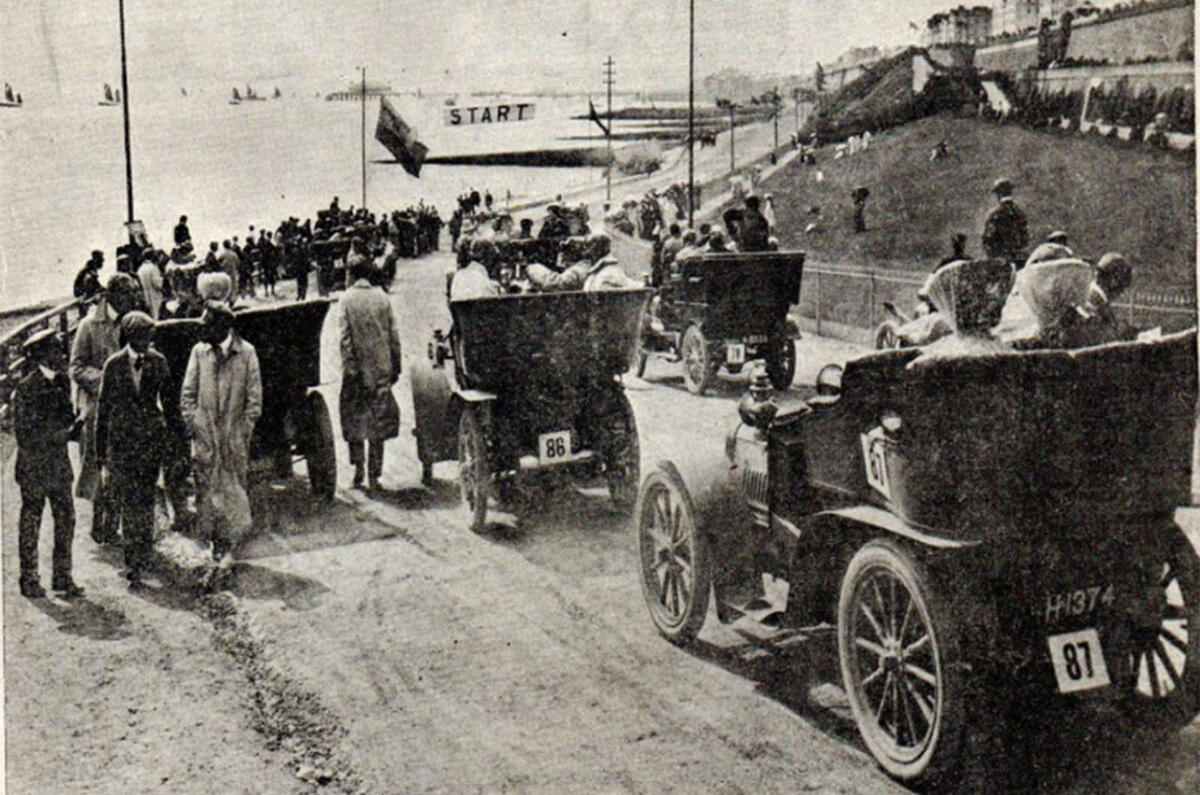On 2 September this year, speed trials will be held beside Brighton beach. They won’t be of any real importance or significance – aside from the fact that this is the world’s longest-running motorsport event.
The metamorphosis of Brighton from a fishing village into a trendy seaside resort occured in the late 1700s, but it fell into decline after a bereft Queen Victoria left the Royal Pavilion in the 1860s.
An ebullient entrepreneur, Harry Preston, was instrumental in its revitalisation, and in 1905 he succeeded (helped by the RAC) in convincing the local council that a ‘motor week’ would further this by attracting massive crowds to see those exciting new machines – cars and motorbikes – race at unprecedented road speeds.
A defensive wall had been built along about 1.5 miles of seafront in 1870, atop which was laid Madeira Road. Being artificial, this was flat and straight, as well as long and wide – very rare in 1905, making it ideal for surfacing with hard, dust-free Tarmac, which had recently been invented, and racing upon.
The long terrace of iron arches between it and the elevated main seafront road additionally would make a perfect viewing platform.

All of this combined for a unprecedently noteworthy and large entry of more than 400 cars. Electrical timing apparatus and a series of telephones allowed the organisers to display cars’ times on blackboards to keep the crowd (supposedly up to 20,000) excited. Wednesday was the first of the four days.
It began in magnificent weather with a race (well, two-car heats leading to a final) of 15bhp Darracqs. Indeed, many cars were shipped from Europe to compete. Then an 8hp Rover beat a Stanley steamer in the sub-£200 race; a Darracq won from 30 cars in the £400-£500 race; and a 28hp Daimler in the £700-£800 race; building to a climax of sub-1000kg racing cars, in which a Napier beat a Mercedes – although the most exciting thing was the immolation of the Dufaux driven by a certain Charles Rolls.
A similarly glorious Thursday brought a race of popular sub-£250 cars, won by a Humber. Next came £300-£500 cars, best of which was the all-new 16hp Rover, revealed at he show. Darracq then scored its second victory of the week and Daimler its second and third.
Again the afternoon ended with sub-1000kg cars, a Mercedes and a Napier producing a splendid race in which they were never far apart. We did note, however, that the long intervals between the events were rather boring the public...
The Friday was another day of blazing sun but sadly started with tragic news: a mechanic had been killed en route after a driver had to suddenly swerve to avoid a tramp. After a race of steam cars, there was much interest in the ladies’ handicap, won by Herbert Lloyd in a Daimler, before Maud Manville proved that women could also beat men in equal machinery.
There was then an all-comers £1 sweepstake, but we called the handicap formulation “absurd” when a 7hp Panhard triumphed. Of most interest was the Daily Mail Challenge Cup, contested by some of Europe’s best racing cars, with “Titanic power”, for a 100-guinea prize.

Clifford Earp broke the British 1km record in a Napier, averaging 93mph, and he shared most of the applause with Dorothy Levitt, in whom the public took great interest. On the Saturday, spectators were treated to the arrival of speed boats, including the world’s fastest, Napier II (30kts!) offshore Then Autocar’s Challenge Cup, for all comers, sadly lacking Earp, due to a twisted camshaft, but still wowing with near-90mph speeds. Algernon Lee Guinness (yes, that Guiness!) won in a 100bhp Darracq.
The touring-car sweepstake next was a fiasco: the handicaps were wrongly reversed, but the drivers couldn’t be found for a rerun... Levitt then asserted her talent again in the final race, a racing car sweepstake, again “driving and handling her powerful [Napier] to win as Guiness failed to finish.
No Brightonian could bemoan the £4000 (that’s £400,000 today) of their taxes having been spent, we thought. Of course we were wrong, but happily their legal challenge failed. The event was picked up again in 1923 and has been run virtually every year since then.
The Autocar Archive, documenting automotive history from 1895 to the present day, is available to readers via digital subscription. If you are an institution, subscribe here.











Add your comment